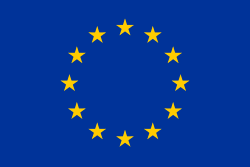In mathematics
Properties
12 is a composite number, the smallest abundant number, a semiperfect number, [11] a highly composite number, [12] a refactorable number, [13] and a Pell number. [14] It is the smallest of two known sublime numbers, numbers that have a perfect number of divisors whose sum is also perfect. [15]
There are twelve Jacobian elliptic functions and twelve cubic distance-transitive graphs.
Shapes
A twelve-sided polygon is a dodecagon. In its regular form, it is the largest polygon that can uniformly tile the plane alongside other regular polygons, as with the truncated hexagonal tiling or the truncated trihexagonal tiling. [16]
A regular dodecahedron has twelve pentagonal faces. Regular cubes and octahedrons both have 12 edges, while regular icosahedrons have 12 vertices.
The cubic close packing and hexagonal close packing, which are the two densest possible sphere packings in three-dimensional space (the Kepler conjecture, proved by Thomas Hales), both have each sphere touching twelve other spheres. Twelve is also the kissing number in three dimensions.
There are twelve complex apeirotopes in dimensions five and higher, which include van Oss polytopes in the form of complex -orthoplexes. [17] There are also twelve paracompact hyperbolic Coxeter groups of uniform polytopes in five-dimensional space.
Bring's curve is a Riemann surface of genus four, with a domain that is a regular hyperbolic 20-sided icosagon. [18] By the Gauss-Bonnet theorem, the area of this fundamental polygon is equal to .
Functions
Twelve is the smallest weight for which a cusp form exists. This cusp form is the discriminant whose Fourier coefficients are given by the Ramanujan -function and which is (up to a constant multiplier) the 24th power of the Dedekind eta function:
This fact is related to a constellation of interesting appearances of the number twelve in mathematics ranging from the fact that the abelianization of special linear group has twelve elements, to the value of the Riemann zeta function at being , which stems from the Ramanujan summation
Although the series is divergent, methods such as Ramanujan summation can assign finite values to divergent series.
List of basic calculations
| Multiplication | 1 | 2 | 3 | 4 | 5 | 6 | 7 | 8 | 9 | 10 | 11 | 12 | 13 | 14 | 15 | 16 | 17 | 18 | 19 | 20 | 21 | 22 | 23 | 24 | 25 | 50 | 100 | 1000 | |
|---|---|---|---|---|---|---|---|---|---|---|---|---|---|---|---|---|---|---|---|---|---|---|---|---|---|---|---|---|---|
| 12 × x | 12 | 24 | 36 | 48 | 60 | 72 | 84 | 96 | 108 | 120 | 132 | 144 | 156 | 168 | 180 | 192 | 204 | 216 | 228 | 240 | 252 | 264 | 276 | 288 | 300 | 600 | 1200 | 12000 |
| Division | 1 | 2 | 3 | 4 | 5 | 6 | 7 | 8 | 9 | 10 | 11 | 12 | 13 | 14 | 15 | 16 | |
|---|---|---|---|---|---|---|---|---|---|---|---|---|---|---|---|---|---|
| 12 ÷ x | 12 | 6 | 4 | 3 | 2.4 | 2 | 1.714285 | 1.5 | 1.3 | 1.2 | 1.09 | 1 | 0.923076 | 0.857142 | 0.8 | 0.75 | |
| x ÷ 12 | 0.083 | 0.16 | 0.25 | 0.3 | 0.416 | 0.5 | 0.583 | 0.6 | 0.75 | 0.83 | 0.916 | 1 | 1.083 | 1.16 | 1.25 | 1.3 |
| Exponentiation | 1 | 2 | 3 | 4 | 5 | 6 | 7 | 8 | 9 | 10 | 11 | 12 | |
|---|---|---|---|---|---|---|---|---|---|---|---|---|---|
| 12x | 12 | 144 | 1728 | 20736 | 248832 | 2985984 | 35831808 | 429981696 | 5159780352 | 61917364224 | 743008370688 | 8916100448256 | |
| x12 | 1 | 4096 | 531441 | 16777216 | 244140625 | 2176782336 | 13841287201 | 68719476736 | 282429536481 | 1000000000000 | 3138428376721 | 8916100448256 |
In other bases
The duodecimal system (1210 [twelve] = 1012), which is the use of 12 as a division factor for many ancient and medieval weights and measures, including hours, probably originates from Mesopotamia.











